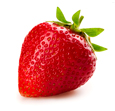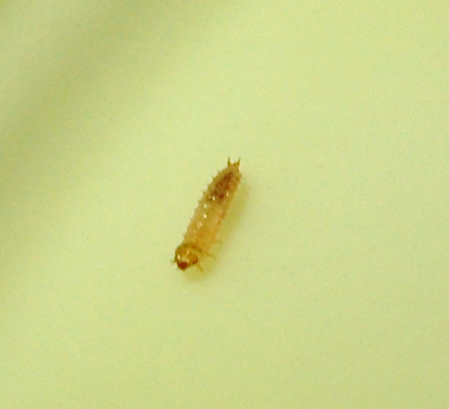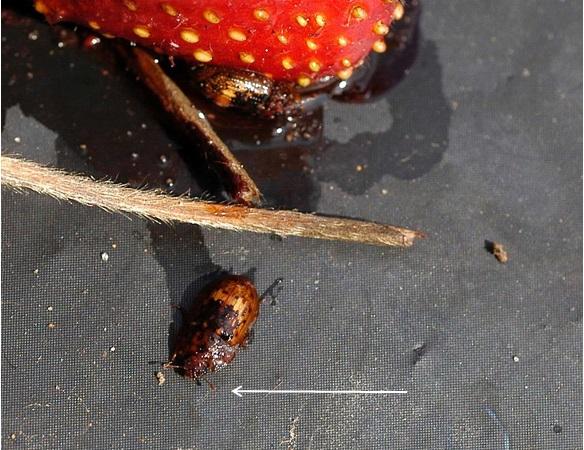Sap Beetle Complex
- Scientific Name(s)
- Carpophilus freemani, C. fumatus, C. humeralis, C. mutilatus, Colopterus insularis, Stelidota geminate, S. ferruginea
- Type
- Arthropod (or insect)
- Fruit Condition
- Insect inside fruit, fruit soft or rotted
- Season
- Harvest
- Cropping System
- Annual plasticulture, Perennial matted row
Biology
Sap beetles are tiny beetles (1⁄4-1⁄8" long) in the family Nitidulidae. At least three species are present in North Carolina, the dusky sap beetle (Carpophilus lugubris), strawberry sap beetle (Stelidota geminata) and fourspotted sap beetle (Glischrochilus quadrisignatus). Most species overwinter as adults, frequently in wooded areas, and migrate into strawberry fields around the time fruit are ripening. Adult sap beetles are attracted to the odor of rotting fruit. Females lay eggs in debris near rotting fruit. The larvae feed inside the fruit, then pupate in the soil nearby their food source. Sap beetle larvae have light brown head capsules, three distinct pair of legs, bristles along their bodies and two projections on the end of their abdomen. After pupation, the adults may also feed upon strawberry fruit.
Damage
Feeding damage primarily occurs in rotting, damaged, or overripe fruit, but will occasionally be seen in sound fruit. Pick your own (PYO) systems may be more susceptible to infestations if not cleaned after consumers. If rotting fruit are present near sound fruit, as can commonly happen when you-pickers aren't thorough or rain prevents picking, sap beetle adults and larvae can also attack sound, otherwise marketable fruit. In addition to damaging the fruit directly, beetles introduce fungi to the fruit that cause it to ferment.
Sampling
In addition to checking fruit for beetle presence, buckets containing rotten fruit or whole wheat bread dough placed in the ground along the edges of the field can be used to monitor the presence of sap beetles. Traps should be checked and baits replaced at least weekly, and old bait should be disposed of offsite.
Management
Cultural
Removal of rotten or overripe fruit from the field is the most important control method for reducing sap beetle populations and is often sufficient to prevent damage.
Chemical
If cultural methods are not sufficient to control sap beetles, foliar sprays can be applied. Refer to the North Carolina Agricultural Chemicals Manual for materials recommended for use against sap beetles in North Carolina and the Southern Region Small Fruit Consortium Strawberry IPM Guide for regional recommendations.
Organic
Good field sanitation is the only effective organically acceptable control method at this time.
For More Information
Distinguishing SWD larvae from other insects in strawberries – Small Fruit IPM Blog
Biology and Management of Strawberry Sap Beetle – Cornell Fruit
North Carolina Agricultural Chemicals Manual
Strawberry IPM Guide – Southern Region Small Fruit Consortium







